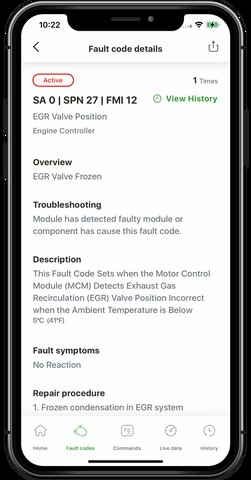Troubleshooting vehicle problems often starts with a glowing check engine light. This light indicates a trouble code, a message from your vehicle’s onboard computer system detailing a potential issue. Understanding these codes, specifically Spn And Fmi Codes, is crucial for efficient diagnostics and repair. This article delves into the meaning of SPN and FMI codes and how they can be used to pinpoint vehicle problems.
J1939, a common communication protocol for vehicle networks, structures trouble codes using three key identifiers: Source Address (SA), Suspect Parameter Number (SPN), and Failure Mode Indicator (FMI). Together, these elements provide a complete Diagnostic Trouble Code (DTC) that helps mechanics quickly understand and diagnose issues.
Decoding the Source Address (SA)
The SA identifies the specific electronic control unit (ECU) reporting the fault. Different ECUs have unique SA values. For instance:
- Engine Control Module (ECM): Often SA 0, but can vary (SA 1 or SA 16 in some Volvo trucks).
- Aftertreatment Control Module (ACM): SA 61
- Body Control Module (BCM): SA 33
- Anti-lock Braking System (ABS): SA 11
- Transmission Control Module (TCM): SA 3
For example, an SA of 0 points to the ECM as the source of the issue, while SA 33 indicates a problem originating from the BCM.
Pinpointing the Problem with SPN Codes
The SPN identifies the specific parameter or component experiencing a fault. SPN 3216, for example, signifies a problem with the Aftertreatment Intake NOx sensor. SPNs can indicate both component failures and operational issues where conditions deviate from expected parameters.
Understanding Failure Modes with FMI Codes
The FMI provides crucial details about the nature of the fault. It clarifies the type of failure detected by the ECU, narrowing down the potential causes. FMIs can indicate various issues, including:
- Circuit Problems: FMI 3, 4, 5, or 6 often signal circuit issues like open circuits, shorts to ground, or abnormal current levels. For instance, FMI 5 might indicate low current or an open circuit, suggesting a broken or disconnected wire.
- Component Failures: FMI 12 suggests a faulty device or component, while FMI 7 indicates a non-responsive or misadjusted component. These FMIs often require component replacement.
- Data Communication Errors: FMI 9 (abnormal update rate) and FMI 10 (abnormal rate of change) point to communication issues within the vehicle’s Controller Area Network (CAN).
- Operational Range Issues: FMI 0 or 1 indicate data outside the normal operating range. This is often seen in aftertreatment systems (DPF, EGR, SCR). For example, FMI 1 coupled with SPN 3364 (Diesel Exhaust Fluid Quality) indicates valid data but below the normal range.
- Special Instructions: FMI 14 indicates a unique fault requiring manufacturer-specific instructions for diagnosis.
- Existing Conditions: FMI 31 signifies a specific condition being met, such as an empty DEF tank or derate status. This often accompanies another, more specific code.
Conclusion
Understanding SPN and FMI codes is fundamental for effective vehicle diagnostics. By decoding these codes, mechanics can pinpoint the source of the problem, the affected component, and the nature of the failure, leading to quicker and more accurate repairs. Utilizing a comprehensive code reader and referencing manufacturer-specific information are essential for correctly interpreting these codes and efficiently resolving vehicle issues.

